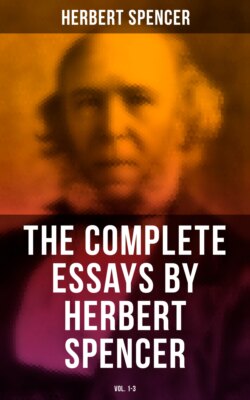Читать книгу The Complete Essays by Herbert Spencer (Vol. 1-3) - Spencer Herbert - Страница 15
На сайте Литреса книга снята с продажи.
FOOTNOTES:
Оглавление[21] Of course there remains the question whether, before the stage here recognized, there had already been produced a high temperature by those collisions of celestial masses which reduced the matter to a nebulous form. As suggested in First Principles (§ 136 in the edition of 1862, and § 182 in subsequent editions), there must, after there have been effected all those minor dissolutions which follow evolutions, remain to be effected the dissolutions of the great bodies in and on which the minor evolutions and dissolutions have taken place; and it was argued that such dissolutions will be, at some time or other, effected by those immense transformations of molar motion into molecular motion, consequent on collisions: the argument being based on the statement of Sir John Herschel, that in clusters of stars collisions must inevitably occur. It may, however, be objected that though such a result may be reasonably looked for in closely aggregated assemblages of stars, it is difficult to conceive of its taking place throughout our Sidereal System at large, the members of which, and their intervals, may be roughly figured as pins-heads 50 miles apart. It would seem that something like an eternity must elapse before, by ethereal resistance or other cause, these can be brought into proximity great enough to make collisions probable.
[22] The two sentences which, in the text, precede the asterisk, I have introduced while these pages are standing in type: being led to do so by the perusal of some notes kindly lent to me by Prof. Dewar, containing the outline of a lecture he gave at the Royal Institution during the session of 1880. Discussing the conditions under which, if "our so-called elements are compounded of elemental matter", they may have been formed, Prof. Dewar, arguing from the known habitudes of compound substances, concludes that the formation is in each case a function of pressure, temperature, and nature of the environing gases.
[23] At the date of this passage the established teleology made it seem needful to assume that all the planets are habitable, and that even beneath the photosphere of the Sun there exists a dark body which may be the scene of life; but since then, the influence of teleology has so far diminished that this hypothesis can no longer be called the current one.
[24] It may here be mentioned (though the principal significance of this comes under the next head) that the average mean distance of the later-discovered planetoids is somewhat greater than that of these earlier-discovered; amounting to 2·61 for Nos. 1 to 35 and 2·80 for Nos. 211 to 245. For this observation I am indebted to Mr. Lynn; whose attention was drawn to it while revising for me the statements contained in this paragraph, so as to include discoveries made since the paragraph was written.
